

World War II: The Holocaust - Alan Taylor - In Focus. One of the most horrific terms in history was used by Nazi Germany to designate human beings whose lives were unimportant, or those who should be killed outright: Lebensunwertes Leben, or "life unworthy of life".
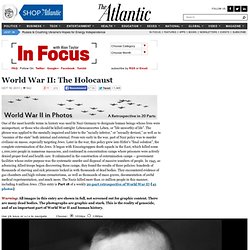
Introduction to the Holocaust. The Holocaust was the systematic, bureaucratic, state-sponsored persecution and murder of six million Jews by the Nazi regime and its collaborators.
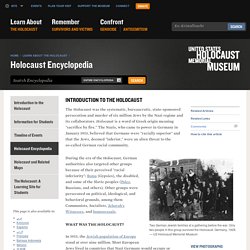
Holocaust is a word of Greek origin meaning "sacrifice by fire. " List of Nazi concentration camps. This article presents a partial list of more prominent German concentration camps set up across Europe during World War II and the Holocaust.
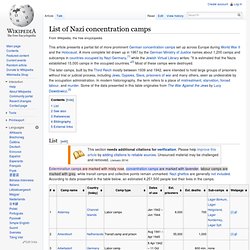
A more complete list drawn up in 1967 by the German Ministry of Justice names about 1,200 camps and subcamps in countries occupied by Nazi Germany,[1] while the Jewish Virtual Library writes: "It is estimated that the Nazis established 15,000 camps in the occupied countries. Triumph of Hitler: Nazis Boycott Jewish Shops. Just a week after the Enabling Act made Hitler dictator of Germany, a national boycott of Jewish shops and department stores was organized by Nazis under the direction of Propaganda Minister Joseph Goebbels.

The boycott was claimed to be in reaction to unflattering newspaper stories appearing in Britain and America concerning Hitler's new regime. The Nazis assumed most journalists were either Jewish or sympathetic to Jews and thus they labeled the bad publicity as "atrocity propaganda" spread by "international Jewry. " The boycott began at 10 a.m. on Saturday, April 1st, 1933, and lasted only a day.
Nazi Hunting News. Courtesy of the United States Holocaust Memorial Museum In the years immediately after World War II, the four Allied powers that occupied Germany -- the United States, Great Britain, France, and the Soviet Union -- resolved to prosecute those individuals responsible for crimes committed against civilian populations under Adolf Hitler's Nazi regime.

Trials were held in domestic and international courts, the most notable of which were the 1945-46 hearings at the International Military Tribunal (IMT) in Nuremberg, Germany. Although many civilian and military leaders were apprehended and brought to justice in the years after the war, many more suspected of Nazi-era war crimes remained at large. Private groups, some led by Holocaust survivors, took it upon themselves to track down Nazi-era war criminals. Auschwitz-Birkenau - Lesson Plans - Education & E-Learning.
Learning and Remembering about Auschwitz-Birkenau Lesson Plan Grades: 10 - 12 Duration: 1.5 - 2 hours Contents: Didactic Objectives: Examine primary resources including testimonies and photographs relating to Auschwitz-Birkenau.Learn about how human beings were dehumanized by other humans, and how Jews were selected upon arrival Auschwitz-Birkenau.Gain insight into how prisoners sought to survive in this extermination camp.

Introduction Policy makers in more than twenty European nations have legislated Holocaust Remembrance days. Guidelines for Holocaust Commemoration. Destruction and Rebirth at Bergen Belsen - Lesson Plans - Education & E-Learning. Destruction and Rebirth at Bergen Belsen Lesson Plan Shoshanna Lockshin, Jackie Metzger and Asaf Tal Grades: 9 - 12 Duration: 1 - 2 hours Contents: This classroom activity explores the transformation of Bergen Belsen from a concentration camp to a Displaced Persons' camp.
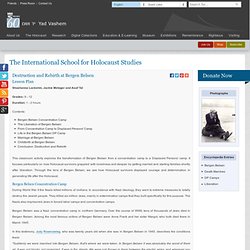
Bergen Belsen Concentration Camp. Holocaust History: Animated Maps. Muslims and Jews in History. Stories - The Date of Infamy - World War II Valor in the Pacific National Monument. The Japanese attack fleet of 33 warships and auxiliary craft, including six aircraft carriers, sailed from northern Japan for the Hawaiian Islands.
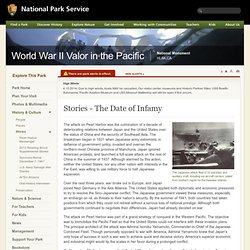
Pearl Harbor History: Why Did Japan Attack? Eyewitness Accounts, Casualty List, Background. September 1940. The U.S. placed an embargo on Japan by prohibiting exports of steel, scrap iron, and aviation fuel to Japan, due to Japan's takeover of northern French Indochina. April 1941. The Japanese signed a neutrality treaty with the Soviet Union to help prevent an attack from that direction if they were to go to war with Britain or the U.S. while taking a bigger bite out of Southeast Asia. June 1941 through the end of July 1941. Japan occupied southern Indochina. Toward the end of 1941. Prior to December 1941, Japan pursued two simultaneous courses: try to get the oil embargo lifted on terms that would still let them take the territory they wanted, and ... to prepare for war.
After becoming Japan's premier in mid-October, General Tojo Hideki See Books about Tojo secretly set November 29 as the last day on which Japan would accept a settlement without war. The Japanese military was asked to devise a war plan. Www.pacifichistoricparks.org/pdfs/December7.pdf. Fact Sheet: Pearl Harbor. The Japanese attack on Pearl Harbor began at 7:55 am on December 7, 1941.
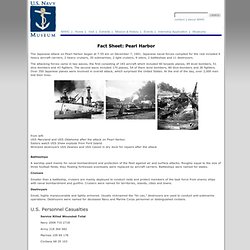
Japanese naval forces compiled for the raid included 4 heavy aircraft carriers, 2 heavy cruisers, 35 submarines, 2 light cruisers, 9 oilers, 2 battleships and 11 destroyers. The attacking forces came in two waves, the first consisting of 183 aircraft which included 40 torpedo planes, 49 level bombers, 51 dive bombers and 43 fighters. The second wave included 170 planes, 54 of them level bombers, 80 dive-bombers and 36 fighters. Over 350 Japanese planes were involved in overall attack, which surprised the United States. Pearl Harbor Attack Map. Pearl Harbor Images. The 7 December 1941 Japanese raid on Pearl Harbor was one of the great defining moments in history.
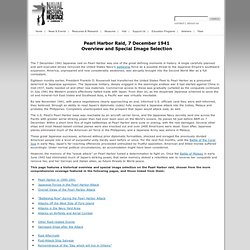
A single carefully-planned and well-executed stroke removed the United States Navy's battleship force as a possible threat to the Japanese Empire's southward expansion. America, unprepared and now considerably weakened, was abruptly brought into the Second World War as a full combatant. Eighteen months earlier, President Franklin D. Roosevelt had transferred the United States Fleet to Pearl Harbor as a presumed deterrent to Japanese agression. The Japanese military, deeply engaged in the seemingly endless war it had started against China in mid-1937, badly needed oil and other raw materials. Report Of Damage, December 7 1941. Pearl Harbor.
ORIGINAL PEARL HARBOR PHOTOS Never seen these before----must be somebody 's private pictures they saved all this time. These pic's are so clear....very sad....but, good that we can see them...... Top 10 Battles of World War II. History. World War 2 Timeline.